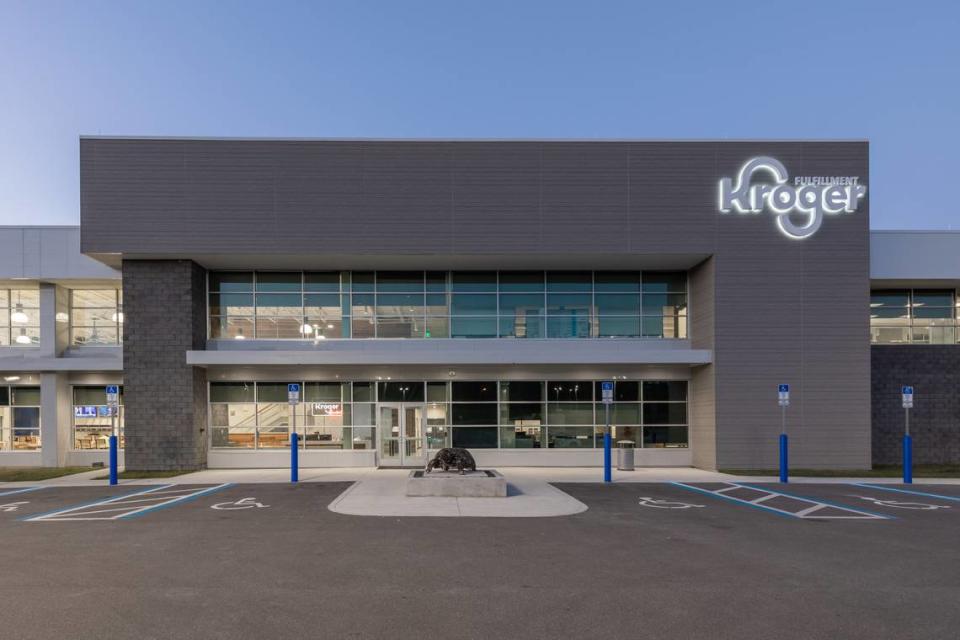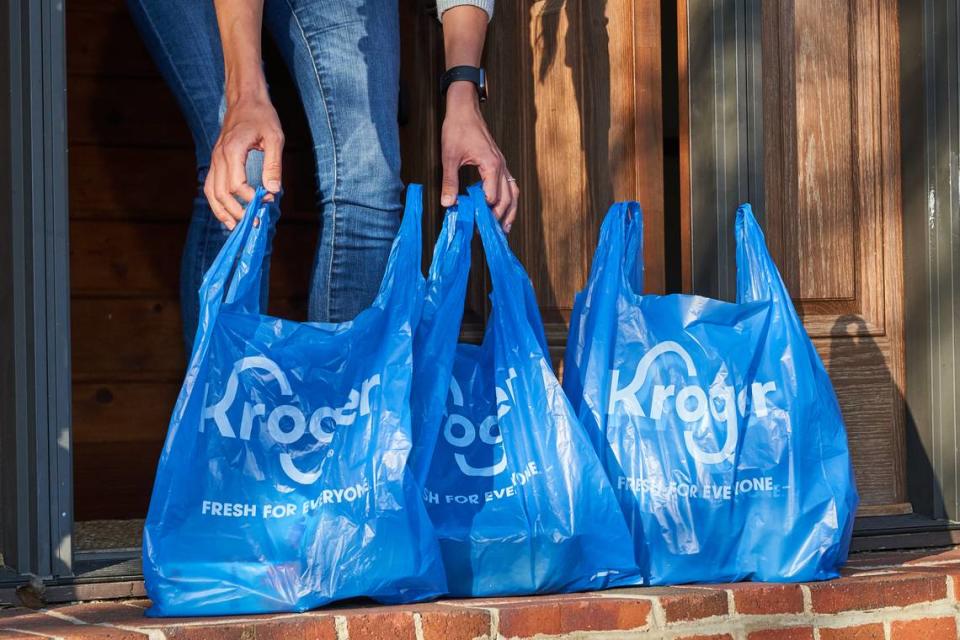Publix is getting some new competition. And this grocer isn’t even opening a supermarket
Kroger, the largest supermarket company in the United States, has moved into Florida. Soon it will open in the Miami-Fort Lauderdale area, too.
But you won’t see a single store.
That’s because the Cincinnati-based Kroger isn’t opening traditional stores across the street from other familiar grocers like Publix, Winn-Dixie and Fresco y Más, Trader Joe’s, Whole Foods, Milam’s and the new-to-South Florida Sprouts Farmers Market. You know, the way it seems there’s a CVS pharmacy on every street corner opposite a Walgreens?
Kroger isn’t opening any brick and mortar stores.
Instead, Kroger’s concentrating on the growing trend of online grocery shopping where customers hover over the Amazon-style “buy” button on apps and summon deliveries to their doors.
Kroger, as familiar a name to its fans in the Northeast as Publix is in the Southeast, recently opened a $55 million central fulfillment center based in Groveland, about 30 miles west of Orlando. That hub can service customers in a 90-mile radius, according to Kroger.
Through its accompanying service locales, or “spoke facilities,” the company can also deliver to customers throughout Central Florida, as well as Tampa and Jacksonville, Fox 4 reported.
“We will continue our momentum by introducing Kroger Delivery to customers in the South Florida market next year,” said the company’s Florida division spokeswoman Andrea Colby. A date is yet to be announced.
How Kroger’s Florida center works

To get the job done, robots prowl grids inside the Groveland warehouse, which, at 375,000-square-feet, is large enough to accommodate eight football fields, reports CNBC.
These storage “sheds” house 31,000 grocery items, like fruits and veggies, household items, frozen foods and more. Hundreds of robots, the size of dishwashers, retrieve products from plastic totes, while people, of course, handle other tasks like stocking the totes and driving the delivery trucks, according to CNBC.
“Kroger understands that innovation is necessary to stay relevant, which has driven the investment in digital and move to break into new markets. Kroger entered the Florida market earlier this year with our e-commerce model. With our centrally located fulfillment center in Groveland and spoke locations in Tampa and Jacksonville, we are successfully serving customers throughout Central Florida,” Colby said.
“The delivery service allows families to conveniently shop for affordably-priced items online and select a delivery time that is based on their needs and busy schedule. We us refrigerated vans to transport the items and Kroger associates deliver orders to our customers’ doors,” Colby said.
Growth of online grocery shopping
Kroger is betting that the home delivery system, fueled in part by the COVID-19 pandemic, continues to capture customers’ fancy.
According to Brick Meets Click, a national group based in Illinois that follows digital trends and offers marketing strategy for the grocery industry, the percentage of U.S. households that used online grocery delivery has grown significantly during the pandemic.
In August 2019, 6% of the households opted for online grocery deliveries. In September 2021, that figure was 18%, according to Brick Meets Click partner David Bishop.
“While grocery delivery was available before the pandemic, it has become a more attractive way to shop given concerns about contracting the coronavirus as well as access to a broader range of shopping services,” Bishop said.
The Lakeland-based Publix — the top grocery chain in Florida and fifth most profitable grocer in the United States, according to Dun & Bradstreet — had tried its own online ordering and home delivery system, Publix Direct, in South Florida. But in 2003, Publix scrapped the service after it failed to catch on with customers, the Tampa Bay Times reported.
Publix’s current home delivery service is via the third-party delivery company Instacart.
Instacart also partners with Albertsons, ALDI, Costco, CVS, Sam’s Club and Sprouts Farmers Market.
Southeastern Grocers, parent company of Winn-Dixie and Fresco y Más supermarkets, works with Uber Eats to get online customers their orders delivered, The Orlando Sentinel reports.
The difference between the Instacart or Uber driver powered stores and the Amazon style Kroger seems to favor is that Publix, et al., relies on someone to walk up and down the aisles of any given store and put items into bags, tag them, and then get the bags driven to customers’ homes. You can think of Instacart like a personal shopper.
A fulfillment center has one purpose and regular customers aren’t moving about the aisles amid the programmed robots and the staffers.
Supermarket wars?

Naturally, this Florida entry by Kroger, which also hopes to tap its name recognition from northerners transplanted to Florida the way a new New Yorker might wistfully wish for a Publix, has stirred talk of competition.
Kroger’s Colby isn’t uttering the “P” word. Or “Winn-Dixie” or “Sprouts,” for that matter.
“We believe that Kroger’s commitment to quality and freshness, outstanding customer service and convenience of grocery delivery, combined with our dedication to making a difference in the lives of our customers, will set Kroger Delivery apart from any competitor,” Colby said.
Publix is not just “any competitor” as the market leader in Florida. The chain rang up 37% of the state’s grocery sales and about $38 billion in revenues in 2019, according to market researcher IRI and Statista, responded in kind.
“For more than 90 years, we have served our customers, associates and communities in Florida,” said Publix spokeswoman Maria Brous. “We have built a loyal following, with raving fans, due to our stellar customer service, high-quality products at competitive prices. We pride ourselves on evolving with our customers and meeting them where they are, in-store or online. Competition makes us all better, and our customers benefit the most.”
Publix’s sales from its 1,239 supermarkets for the six months ended June 26, 2021, were $23.5 billion, a 3.9% increase from $22.6 billion in 2020. Same-store sales for the six month period increased 2.4%, according to Progressive Grocer.
Meantime, Kroger had fiscal 2020 sales of $132.5 billion from its nearly 2,800 stores in 35 states. (Walmart was No. 1 with $433.9 billion from grocery sales but is not technically considered a grocery store.) Southeastern, and its 600 stores in the Southeast United States was ranked 31st nationwide with $9.64 billion from 523 stores.)
Southeastern Grocers, in a statement provided by spokeswoman Meredith Hurley from the Jacksonville office, said: “While the majority of our core customers currently shop in our stores, we recognize the importance of creating a seamless customer experience for our customers, wherever and whenever they chose to shop with us — and we’re continuing to evolve our options on how they can do so conveniently and at a great value.
“Our eCommerce program has been customized so that we can continue to build our smart localization relationship with the consumer even when they use a third party. And we’ll continue to advance in our e-commerce offerings, as we now have delivery available in 87% of our stores,” the statement said.
Southeastern said it is having success with the UberEats and Shipt partnerships that have reduced wait time from order to delivery to about two hours.
“Nearly 40% of our eCommerce orders in South Florida Winn-Dixie stores and more than 65% of our Fresco y Más orders are coming from the UberEats app,” Southeastern said. “We’ve found that that high usage of this service is due to the bilingual functionality it provides our customers. We will continue to listen to our customers and the communities we serve, constantly adapting and improving our offerings to provide for their changing needs.”

